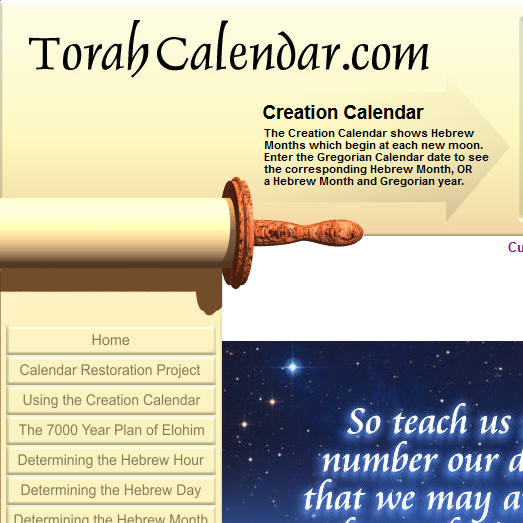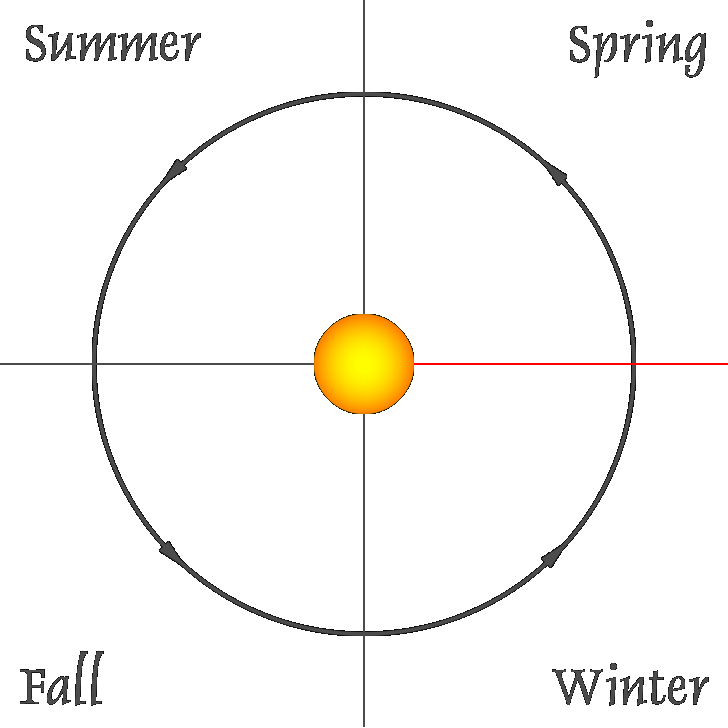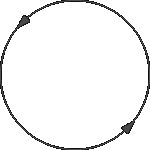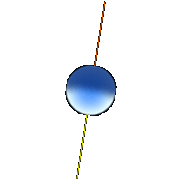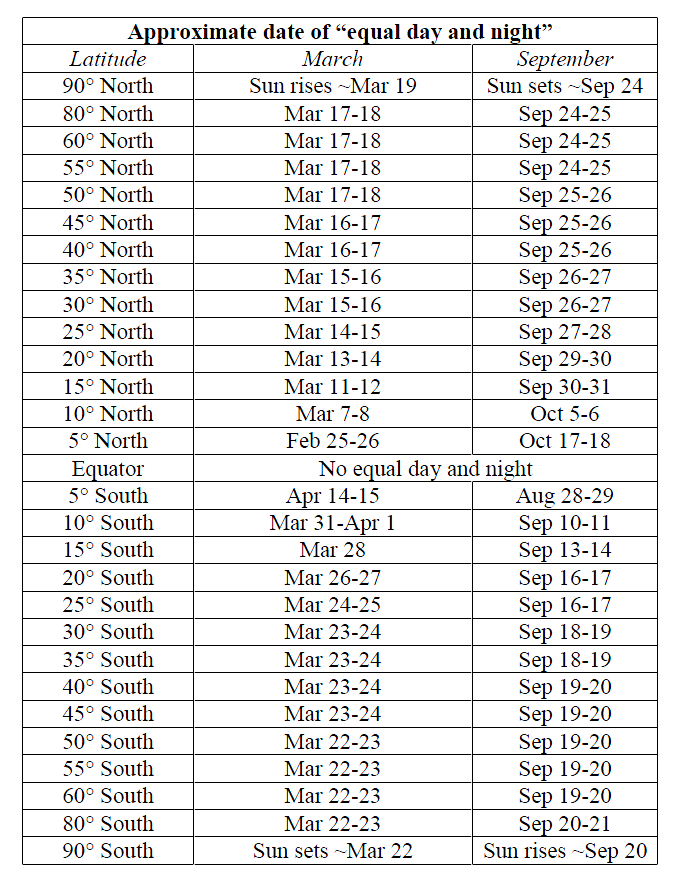Determining the Hebrew Year
The Spiritual Year begins at the moment of sunset at Jerusalem, on the evening
of the first potentially visible crescent moon beginning Day 1 of Month 1.
A Spiritual Year can begin before or after the spring equinox.
The rule of the equinox always places Day 15 of
Month 1 on or after
the Hebrew Day of the spring equinox, and Month 1 should begin as soon as possible in spring
to fulfill
Exodus 12:29.
A Hebrew Year always contains 12 Hebrew Months
in a regular year or 13 Hebrew Months in a leap
year. The Spiritual Year begins on Day 1 of Month 1
based on the rule of the equinox, while the typical Civil Year begins on
Day 1 of Month 7. Once every 50 years the special Jubilee Year
begins on Day 10 of Month 7.
The Spiritual Year Begins in Spring in Month 1
In
Exodus 12:2,
יהוה
instructed Moses and Aaron to reckon the month of the Exodus as "the head of the months," and so
this month is the first Hebrew Month of a Spiritual Year.
From
Exodus 13:4,
Exodus 23:15,
Exodus 34:18
and
Deuteronomy 16:1,
we learn that the Exodus occurred in spring when the barley was ripening.
A Spiritual Year can have either 12 Hebrew Months or 13 Hebrew Months.
According to the rule of the equinox, there will always be a Spiritual Leap Year every second or third year.
12 Month Spiritual Regular Year
13 Month Spiritual Leap Year
The Civil Year Begins in Fall in Month 7
In
Leviticus 25:8-10,
יהוה
told Moses to sound the trumpet in the Jubilee Year on Day 10 of Month 7.
By doing this, the Jubilee Year is consecrated from a Regular Civil Year which
begins on Day 1 of Month 7.
Therefore, as a Jubilee Year begins in Month 7, so to does every Civil Year
begin in Month 7.
Color coding helps
distinguish between
the various types of
Civil Years
The corresponding Civil Year
Civil Years always begin in
Month 7 of the Spiritual Year
Roman Christianity uses a purely solar calendar, whereas
Islam uses a purely lunar calendar.
However, it is important to understand that the Creation Calendar is
not a lunar calendar, nor a solar calendar.
Instead, the Scriptural Creation Calendar is a luni-solar calendar
following the created purpose of
the sun and moon according to
Genesis 1:14-17.
According to
Deuteronomy 32:46-47,
these are life and death distinctions!
Visualizing How the Rule of the Equinox Determines a Hebrew Year
Day 1, Month 3,
2024 C.E.
Day 1, Month 4,
2024 C.E.
Day 1, Month 5,
2024 C.E.
The Creator's Clock
The moon travels around the earth once every lunar cycle.
From a heliocentric perspective, the earth travels around the sun once every solar cycle.
The diagram above shows the position of the moon and the earth, in relation to the
sun, for any date. Equinoxes and solstices are designated by long lines dividing the
year into its four seasons.
Arrows on the gray circles show the direction of travel for the motions of
the moon and earth. The dots mark the daily positions of the moon throughout the month.
Three months are shown, one on either side of the Hebrew Month indicated.
This graphic illustrates how the Creation Calendar uses both the sun and moon to
calculate days, months and years. It is helpful for visualizing
how the rule of the equinox is used to intercalate a leap month. The
spring equinox is represented by a red line in this diagram.
The rule of the equinox states that if by Day 15 of the Hebrew Month
following Month 12, the center of the earth is on or
has already crossed the red line of the spring equinox,
then the month following Month 12 is Month 1. If by Day 15 of the
Hebrew Month following Month 12 the earth has not yet crossed the
red line, then the month following Month 12 is Month 13. The rule of the equinox
is a perfect judgment of Elohim for determining the Hebrew Year.

Deuteronomy 32:3-4 For I proclaim the name of
יהוה
:
Ascribe greatness to our
Elohim. He is the Rock, His work is perfect, for all His ways are judgment, an
Elohim of truth and without iniquity, righteous and upright is He.
This diagram is a simplified representation of the motions of the earth and the moon.
Although depicted as circles, the orbits of the earth and moon actually have an
elliptical shape which looks more like an oval. Likewise, the speed of travel at points
along these orbits varies throughout the year. For example, the earth travels slightly faster when it is
closer to the sun than when it is further away. For this diagram, the orbits are shown
as circles since visually, their elliptical aspect is minimal. However, the relative
positions of the earth and moon as time progresses are rendered correctly. Therefore, in
this diagram, the passage of the earth across the equinox and solstice lines will always
occur on the correct dates.
The daily positions of the moon, shown as dots on this diagram, appear to form
a spiral pattern suggesting that the moon occasionally overlaps its path. However,
this does not occur in the physical solar system. The spiral pattern results because the
objects and relative distances shown in this diagram are not drawn to scale. For example, the
average distance between the earth and sun is nearly 400 times the distance
between the earth and the moon. Although this graphic is not drawn to scale, it correctly
represents the orientations of the earth and the moon with respect to time.
The Equinoxes
An equinox occurs twice a year, when the tilt of the earth's axis is
inclined neither away from nor towards the sun, the sun being vertically above
a point on the equator. The term equinox can also be used in a broader
sense, meaning the date when such a passage happens. The name equinox
is derived from the Latin aequus (equal) and nox (night), because
around the equinox, the night and day are approximately equal in length.
Contrary to its etymology, the term equinox is not the time or the day
when day and night are of equal duration.
People have been led to believe by standard dictionary definitions that the term equinox
refers to the two times each year when the sun crosses the equator
and day and night are of equal length all over the world.
Although the first part of the definition is correct, the second part is not correct.
The term equinox is often incorrectly equated with the term equilux which is discussed below.
An equinox is defined as the time when the apparent geocentric longitude
of the sun (that is, calculated by including the effects of aberration
and nutation) is either 0 degrees (the spring equinox) or 180 degrees
(the fall equinox).
At an equinox, the sun is at one of two opposite points on the celestial sphere
where the celestial equator (i.e. declination 0) and ecliptic
intersect. These points of intersection are called equinoctial points:
the vernal point and the autumnal point. By extension, the term
equinox may denote an equinoctial point. An equinox happens each
year at two specific moments in time (rather than two whole days), when there
is a location on the earth's equator where the center of the sun can be observed
to be vertically overhead, occurring around March 20 and September 22
on the Gregorian Calendar.
The Equinox in Contrast to The Equilux
The date at which the time between sunset and sunrise crosses 12 hours is known
as the equilux. Because sunset and sunrise times vary with an observer's
geographic location (longitude and latitude), the equilux likewise depends
on location and does not exist for locations sufficiently close to the equator.
The equinox, however, is a precise moment in time which is
common to all observers on earth. The Creation Calendar does not use the
equilux to determine the seasons as it is not a precise moment in time - it
uses the equinox.
On the day of an equinox, the center of the sun spends a roughly equal amount of
time above and below the horizon at every location on the earth, night and day
being of roughly the same length. Although the word equinox derives from
the Latin words aequus (equal) and nox (night); in reality, the
day is longer than the night at an equinox. A day is commonly defined as
the period when sunlight reaches the ground in the absence of local obstacles.
From the earth, the sun appears as a disc rather than a single point of light,
so when the center of the sun is below the horizon, its upper edge is visible.
Furthermore, the atmosphere refracts light, so even when the upper limb of the
sun is below the horizon, its rays reach over the horizon to the ground. In
sunrise / sunset tables, the assumed semidiameter (apparent radius) of the sun
is 16 minutes of arc and the atmospheric refraction is assumed to be 34 minutes
of arc. Their combination means that when the upper limb of sun is on the
visible horizon, its center is 50 minutes of arc below the geometric horizon,
which is the intersection with the celestial sphere of a horizontal plane through
the eye of the observer. These cumulative effects make the day about 14 minutes
longer than the night at the equator and longer still towards the Poles. The real
equality of day and night only happens in places far enough from the equator to
have a seasonal difference in day length of at least 7 minutes, actually occurring
a few days towards the winter side of each equinox.
This chart appears on page 39 of a document entitled "Ancient Observatories - Timeless Knowledge"
which was compiled in 2015 by Deborah Scherrer for the Standford Solar Center. Permission for use
was given for educational, non-commercial purposes.
The Solstices
A solstice is an astronomical event that happens twice each year, when the
tilt of the earth's axis is most inclined toward or away from the sun, causing the
sun's apparent position in the sky to reach its northernmost or southernmost
extreme. The name is derived from the Latin sol (sun) and sistere
(to stand still), because at the solstices, the sun stands still in declination;
that is, the apparent movement of the sun's path north or south comes to a stop
before reversing direction. The term solstice can also be used in a broader
sense, as the date (day) when this occurs. The summer solstice occurs around June 21
and the winter solstice around December 21 on the Gregorian Calendar.
The average duration of an astronomical solar year is approximately 365.243 days
based upon calculations of earth's orbit around the sun over a 7000 year period.
A precise solar calendar would be one synchronized to the astronomical solar year where
the calendar days on which the equinoxes and solstices occur from year to year are
not allowed to drift over time.
Julius Caesar, intending to create such a calendar, introduced the Roman Julian Calendar
in 46 B.C.E.
The Julian year had 365 days where every fourth year added a leap day
resulting in an average year length of 365.25 days per year. The Julian Calendar, which
was used until
October 4, 1582 C.E., was eventually replaced by the more precise
Gregorian Calendar. The newer Gregorian Calendar with its average year length of
365.243 days, better approximates the astronomical solar year, thereby further reducing
equinox and solstice drift over time.
The Gregorian Calendar also corrected a 10 day drift of the equinoxes and solstices
that had gradually resulted from using the less accurate Julian Calendar.
The proleptic Julian Calendar is a theoretical retro-calculated calendar. It uniformly
extends the Julian Calendar from 1582 C.E. backwards in time until the creation of the
universe. However, as it is less accurate in approximating the astronomical solar year,
significant drift can be seen in the timing of the equinoxes and solstices over thousands
of years. The accumulated error in the proleptic Julian Calendar is approximately seven
days per 1000 years. Going back in time 4000 years from 1582 C.E., the equinoxes and
solstices appear to drift forward about a whole month.
The Hebrew Day of Equinoxes and Solstices
A Hebrew Day begins and ends at the time of local sunset.
However, a Hebrew Month is determined by
first potential crescent visibility at Jerusalem in accordance with
Psalm 137:5.
On the Creation Calendar, the Hebrew Day of an equinox or solstice is displayed with a
yellow rectangle to indicate this event. Sometimes the moment of an equinox or
a solstice occurs after sunset at Jerusalem but before midnight Universal Time.
If this occurs, a yellow triangle is shown on the Hebrew Day in question
to show this anomoly, and a yellow rectangle appears on the Hebrew Day
in which the moment of the equinox or solstice occurs.
A yellow rectangle at the bottom of a day indicates an equinox or solstice
event occurs during that day. The precise time of the event
is displayed inside this yellow rectangle area.
Equinox or Solstice After Sunset
If an equinox or solstice event occurs after sunset in Jerusalem on the
Gregorian/Julian date listed in almanacs, then a yellow triangle appears for
that day. A yellow rectangle indicates the equinox or solstice event on
the correct Hebrew Day.
The Seasons
The solstices together with the equinoxes are the demarcation
points dividing the seasons in the Creation Calendar. The Hebrew Scriptures
use the word
תקופת
tekufot to describe the two ends of heaven in the sun's circuit as viewed
from earth — the spring and fall equinoxes.
The spring tekufot is used as the orientation point to
determine the entire Hebrew Year. The word tekufot appears in various
forms four times in Scripture.

Exodus 34:22 And you shall observe the Feast of Weeks, of the firstfruits
of wheat harvest, and the Feast of Ingathering at the
תקופת
turn of the year
.

1 Samuel 1:20 So
לתקפות
in the course of time
Hannah conceived and gave birth to a son. She named him Samuel, saying,
"Because I asked
יהוה
for him."

2 Chronicles 24:23 Now it happened at the
לתקופת
turn of the year
that the army of the Arameans came up against him [Joash]; and they came to Judah
and Jerusalem, destroyed all the officials of the people from among the people,
and sent all their spoil to the king of Damascus.

Psalms 19:4-6
In them He has set a tabernacle for the sun, which is as
a Bridegroom coming out of His chamber, as a champian rejoices to run a race.
It rises at one end of heaven
ותקופתו
and makes its circuit to the other end, and there is nothing hidden from its heat.
According to
Exodus 34:22,
the tekufot occurs in the season of
fall during the Feast of Ingathering. The reference in
2 Chronicles 24:23
is probably to the season of
spring when many battles were fought in the ancient world.
The passage in
Psalms 19:4-6
indicates the tekufot is based on the
cycle of the
sun. The account in
1 Samuel 1:20
links the word tekufot
לתקפות
with the birth of Samuel which apparently was in the season of fall.
The word tekufot is translated in this verse as in the course of time.
The traditional date for
Samuel's birth
is Day 1 of Month 7 on Yom Teruah as Rosh Hashanah
11A says Hannah was visited on this day. Ta'anis 5B says Samuel lived 52 years, but in
1 Samuel 12:1-2,
Samuel in his farewell address said he was old and gray headed.
Based on
1 Samuel 1:20,
Samuel was likely born on Yom Teruah on the fall equinox
on
Day 1 of Month 7 in 1074 B.C.E.
Megillas Ta'anit says that Samuel died on Day 28 of Month 2 which was likely on
Day 28 of Month 2 in 1002 B.C.E.
According to this understanding Samuel would have been
71 years old when he died.
The Rule of the Equinox
Elohim created the sun to rule the day and the moon to rule the night, to separate the
day from the night and to divide light from darkness. The results of this creative act
are seen every day and every night. The sun and the moon were created for signs which
are occasionally visible in solar and lunar eclipses. They were also created for
appointed times. This point is not understood by many who follow calendars not
concerned with the movements of the sun and moon. The sun and the moon
were also created for calculating days and for calculating years.

Genesis 1:14-19 Then Elohim said, "Let there be lights in the
firmament of the heavens to divide the day from the night; and let them be for
signs and appointed times, and for days and years; and let them be for
lights in the firmament of the heavens to give light on the earth," and it was so.
Then Elohim made two great lights: the greater light to rule the day, and
the lesser light to rule the night. He made the stars also. Elohim set them
in the firmament of the heavens to give light on the earth, and to rule over the day
and over the night, and to divide the light from the darkness. And Elohim saw that it
was good. So the evening and the morning were the fourth day.
יהוה
Elohim requires that three times every year all males of Israel are to appear before Him
in Jerusalem.

Exodus 23:14-17 Three times a year you are to keep a festival to Me. You shall
keep the Festival of Unleavened Bread: You shall eat unleavened bread seven days, as I
commanded you, at the appointed time of the month of Aviv [Month 1], for in it you came
out from Egypt, and none shall appear before Me empty, and the Festival of Harvest
[Shavuot], the firstfruits of your labors which you have sown in the field, and the
Festival of the Ingathering [Sukkot], which is in the end of the year when you have
gathered in the labors out of the field. Three times in the year shall all your males
appear before the Master
יהוה.

Deuteronomy 16:16 Three times in a year shall all your males appear before
יהוה
your Elohim in the place which He shall choose; in the Feast of Unleavened Bread, in
the Feast of Weeks [Shavuot], and in the Feast of Tabernacles [Sukkot]: and they shall
not appear before
יהוה
empty.
All three festivals need to take place within a single year.
The Creation Calendar keeps the agricultural festivals properly oriented to the solar cycle
(tropical year) which today is believed to be 365 days, 5 hours 49 minutes 19 seconds in duration.
The ancient Israelites, some of whom wrote the Scriptures containing specific dates from the
Creation Calendar, were well aware of the need for the Hebrew Year to stay properly tethered
to the solar cycle (tropical year). They adhered to the rule of the equinox to ensure that this
happened. For this reason, the Creation Calendar is superior in an error tolerance analysis to any
other calendar. It ensures that Unleavened Bread will always be kept in its season
from year to year as
Exodus 13:10
instructs.

Exodus 13:10 You shall therefore keep this ordinance [the Festival of Unleavened Bread]
in its season from year to year.
Elohim created the sun and the moon for calculating years, and the equinoxes and
solstices are His demarcation points in the solar cycle. In calculating
a Hebrew Year, the spring equinox governs the start of a Hebrew Year according
to
Exodus 12:1-2.
The spring equinox is the demarcation point governing the solar cycle.
The first day of Unleavened Bread on Day 15 of Month 1 is the critical day for
calculating a Hebrew Year. In the Creation Calendar,
the first day of Unleavened Bread on Day 15 of Month 1
always occurs on or after the Hebrew Day of the spring equinox.
The first day of Unleavened Bread never occurs before the spring equinox. This ensures
that all three festivals take place within a single year as
יהוה
specified.
This rule is called the rule of the equinox, and it always places Day 15 of Month 1
on or after the Hebrew Day of the spring equinox.
If at the moment of sunset at the end of Month 12, on the evening of the
first crescent moon at Jerusalem, there are 15 Hebrew Days
or less until the spring equinox, then Month 1 is declared. If there are 16
Hebrew Days or more until the spring equinox, then Month 13 is declared.
The spring equinox will always occur on or between Day 16 of Month 12
in a Spiritual Regular Year, and Day 15 of Month 1 in the
year following.
The spring equinox will always occur on or between Day 16 of Month 13 in a Spiritual Leap Year,
and Day 15 of Month 1 in the
year following.
The spring equinox is defined as the time when the apparent geocentric longitude of the
sun (that is, calculated by including the effects of aberration and nutation)
is 0 degrees. The Creation Calendar only intercalates, or inserts an
extra month, at the end of Month 12. The intercalary month is called Month 13.
In the Creation Calendar, the reference point for sighting the new moon is the
vicinity of the Temple Mount in Jerusalem. This is one reason that the location of the
Temple Mount is so intrinsically important.
Regarding the rule of the equinox, it should be mentioned that there are currently some
who are teaching that a Hebrew Year is reckoned from the first new moon
after the spring equinox. It can be proven from a set of historical
records called the Elephantine Letters, that this is the way the ancient Persians
reckoned their year between 458 - 351 B.C.E. However,
יהוה
clearly instructed Israel not to
follow the way of the nations in
Jeremiah 10:1-2.
As the Persians followed the way
of Zoroastrianism, it is easy to determine that this method of determining when a year
begins is not the narrow way that leads to life spoken of by
יהושע
the Messiah in
Matthew 7:13-14
and
Luke 13:24-30.
A Close Call in 2011 C.E.
Sometimes, the spring equinox can occur on the first day of Unleavened Bread
on Day 15 of Month 1. An example of such a borderline case is
Month 1 of 2011 C.E. The
Creation Calendar
shows the
spring equinox occurring on Day 15 ofMonth 1 on March 20 at
23:21 UT (Universal Time). The
Sunset Calculator
shows the sun sets at Jersualem at the end of Day 14 of Month 1 on March 20,
2011 C.E. at 15:50 UT.
Adjusting for Israel's time zone adds two hours to UT putting sunset at
17:50 IST (Israel Standard Time) which is
5:50 PM IST. Since the spring equinox occurs well after sunset ending
Day 14 of Month 1, it clearly occurs within Day 15 of Month 1.
For Day 15 of Month 1 in 2011 C.E., the
Creator's Clock
shows the earth centered on the red line designating the spring equinox. This
diagram graphically depicts the rule of the equinox showing it is Month 1 instead
of Month 13 of the previous year. The
New Moon at Jerusalem at the Moment of Sunset
verifies that the crescent
moon can be seen at sunset on March 6, 2011 C.E. which begins Day 1 of Month 1
of the new Hebrew Year. By viewing
the sunset diagram for the day before, one can easily verify that the moon would
not be seen at sunset on March 5.
So in the year 2011 C.E., how close is Month 1 from being Month 13 of the previous year?
The
Sunset Calculator
shows the sun sets at Jersualem at the end of Day 15 of Month 1 on March 21, 2011 C.E.
at 15:51 UT (5:51 PM IST).
Therefore, the
spring equinox occurs a mere 16 hours and 30 minutes before the time when
the rule of the equinox would have declared the month to be Month 13.

Deuteronomy 32:3-4
I will publish the name of
יהוה:
ascribe greatness to our Elohim.
He is the Rock, His work is perfect: for all His ways are judgment: an Elohim of Truth and without iniquity,
just and right is He.
Ripening Barley Does Not Determine the Hebrew Year
Elohim has clearly declared that the sun and the moon are to determine both days, years,
and appointed times which occur at very specific times of the lunar month. So why
do some people critically observe the developmental stage of barley at the end of
Month 12 in attempting to determine when a Hebrew Year begins? Although many
reasons will be given
by those engaging in this practice, the ultimate truth is that they do not believe
Elohim on this issue. Elohim said that the sun and and the moon were
created to determine years.

Genesis 1:14-19 Then Elohim said, "Let there be lights in the
firmament of the heavens to divide the day from the night; and let them be for
signs and appointed times, and for days and years; and let them be for
lights in the firmament of the heavens to give light on the earth," and it was so.
Then Elohim made two great lights: the greater light to rule the day, and
the lesser light to rule the night. He made the stars also. Elohim set them
in the firmament of the heavens to give light on the earth, and to rule over the day
and over the night, and to divide the light from the darkness. And Elohim saw that it
was good. So the evening and the morning were the fourth day.
In the time of Noah's flood there was no barley to observe, however precise
calendrical dates are given in Scripture. There was no barley for the 40 years the
children of Israel were in the wilderness, however precise calendrical dates are
given in Scripture. If there is a drought in the land of Israel there may be no
barley, but the Hebrew Year will still begin. Declaring festivals in the name
of the Creator in a way in which Elohim did not prescribe does not please Him.
Aaron and Jeroboam both ordained festivals for Israel which they had devised in their
own hearts and it was considered by
יהוה as idolatry.
Aaron's sin is now commemorated as a fast on Day 17 of Month 4.
Jeroboam's sin is
commemorated as a fast on Day 23 of Month 3.
